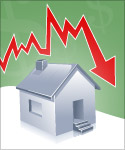
Although the overall health of the economy is of interest to everyone, if you're a banker you particularly want to know when people will start borrowing money again.
Very roughly speaking, banks typically hold equal amounts of commercial loans, commercial real estate loans, home mortgages, consumer loans, government securities, and cash. With commercial, mortgage, and consumer lending sharply lower in the last few years, banks now hold more government securities and a lot more cash, both of which don't produce much income.
In the sequence of recovery, credit cards and auto loans will come first, mortgages probably last.
The latest economic data suggest very strongly that consumers are now willing to increase their credit spending. Jobs in retail trade in November were up 1.6 percent from a year ago, a strong increase. And retail sales of cars in October were up 7 percent from last year. This last number is especially significant because cars are bought with credit. If consumers are willing to take on the debt of a new car, they have shifted the view of their own economic situation from bad to good.
Recovery in mortgages will take longer. 10 percent of banks' mortgages are still delinquent and home prices in the third quarter were down an average 4 percent from last year. Home prices were down in all of the 100 largest markets. We won't see an increase in mortgage borrowing until prices stop going down–which they'll only do once people start buying again. Right now a very thin market is determining home prices.
The worst markets are the usual suspects in Florida, Nevada, California and Arizona, but with Boise, Tacoma, Atlanta and Minneapolis thrown into the mix. But renewed job growth in some of these markets will alter the situation in 2012.
Overall, jobs in November were up 1.2 percent over last year. As usual, the most new jobs were added in health care, but three other areas were significant: manufacturing, where jobs increased 1.7 percent, temporary help, up 7.3 percent, and trucking, up 2.6 percent. Good job growth in these areas means stronger economic activity is already here.
What do you think about the national economic outlook?



